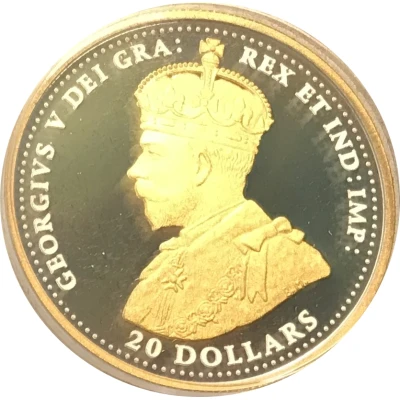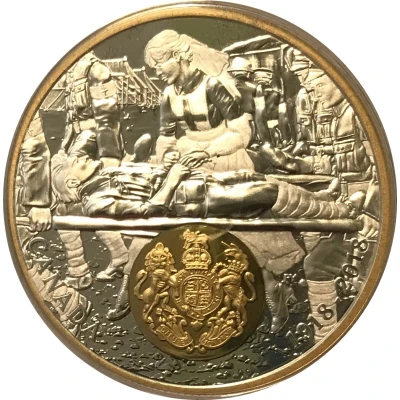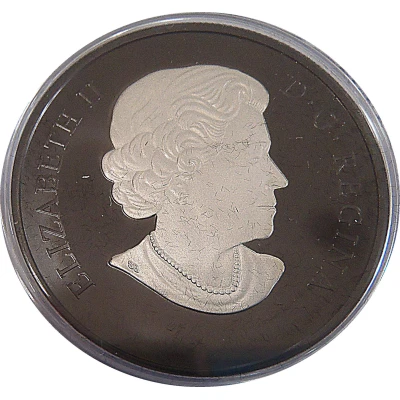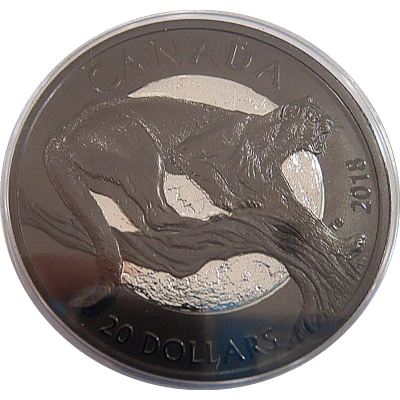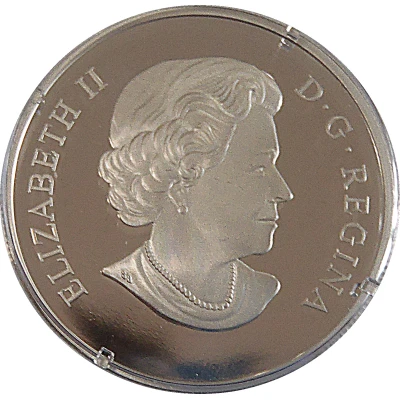
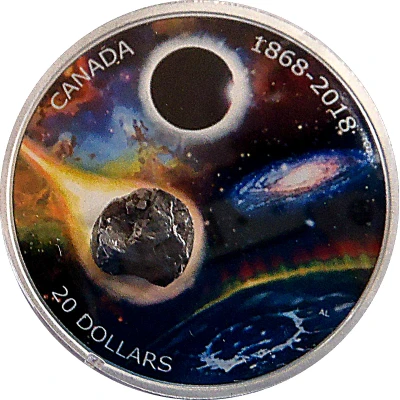

20 Dollars - Elizabeth Royal Astronomical Society
2018 year| Silver (.9999) | 31.39 g | 38 mm |
| Issuer | Canada |
|---|---|
| Queen | Elizabeth II (1952-2022) |
| Type | Non-circulating coin |
| Year | 2018 |
| Value | 20 Dollars 20 CAD = USD 15 |
| Currency | Dollar (1858-date) |
| Composition | Silver (.9999) |
| Weight | 31.39 g |
| Diameter | 38 mm |
| Shape | Round |
| Technique | Milled, Coloured |
| Orientation | Medal alignment ↑↑ |
| Updated | 2024-10-04 |
| Numista | N#148167 |
|---|---|
| Rarity index | 88% |
Reverse
Designed by Alexandra Lefort, your coin is a re-interpretation of The Royal Astronomical Society of Canada’s sesquicentennial logo in a scientifically accurate, photorealism art style. The original logo features stars that allude to Canadian contributions to stellar spectroscopy and photometry, and a globular cluster that honours the scientific work of Helen Sawyer Hogg and Canada’s cooperative partnerships; both are colourfully re-imagined here as the Eagle Nebula—specifically the pillars of interstellar gas and dust known as the Pillars of Creation, wherethe formation of new stars is a symbolic representation of the RASC’s beginnings (and by extension, its anniversary).
Script: Latin
Lettering:
CANADA 1868-2018
20 DOLLARS
AL
Designer: Alexandra Lefort
Edge
Serrated
Comment
A fixture in RASC public outreach efforts, the Moon was chosen to represent the lunar calendars of the First Nations peoples, and the navigational astronomy that guided many European discoverers during Canada’s early history. Beneath it, the Andromeda galaxy—the nearest major galaxy to our own—is a symbolic ode to Canadian contributions to cosmology.Blazing as it burns through Earth’s upper atmosphere, the depiction of a meteor is topped by a genuine iron meteorite fragment sourced from the Campo del Cielo meteorite fields, where the impact craters date back an estimated 4,500 years. Both the meteorite and the view of the Manicouagan crater in Quebec are a nod to the RASC’s longstanding interest in the study of planet geology, meteor dynamics and impact cratering, and to the excellence of Canadian research in these fields. Always fascinating, the space-weather phenomenon of the aurora borealis adds a “True North”flourish that a design that encapsulates 150 years of exploring the cosmos. The reverse also includes the word “CANADA”, the double commemorative dates “1868–2018”, and the face value “20 DOLLARS”. The obverse features the effigy of Her Majesty Queen Elizabeth II by Susanna Blunt.
About the Meteorite
Front and center on your coin, the extraterrestrial piece ofour solar system was sourced from the Campo del Cielo meteorite field in Argentina, where a large fragment was first documented in 1576. A polycrystalline coarse octahedrite, the IA iron meteorite was recovered from one of 26 impact craters formed roughly 4,500 years ago, when a shower of metallic meteorites dispersed fragments across an area of roughly 320 square kilometres. The typical composition of a Campo del Cielo meteorite is 92.7% iron, 6.15% nickel, 0.42% cobalt, 0.37% carbon and 0.28% phosphorus.
Packaging:
Your coin is encapsulated and presented in a Royal Canadian Mint-branded maroon clamshell with a black beauty box.
Interesting fact
One interesting fact about the coin is that it features an image of Queen Elizabeth II, but it's not the typical portrait you'd expect. Instead, it shows her in a more relaxed pose, looking up at the stars, symbolizing her interest in astronomy. This design was created specifically for the Royal Astronomical Society and it's a unique departure from the traditional depictions of the Queen on Canadian currency.
Price
| Date | Mintage | VG | F | VF | XF | AU | UNC |
|---|---|---|---|---|---|---|---|
| 2018 | 5500 | - | - | - | - | - | - |
Values in the table are based on evaluations by sales realized on Internet platforms. They serve as an indication only for 20 Dollars - Elizabeth (Royal Astronomical Society) 2018 coin.
